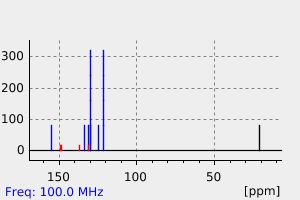Benzenamine, 4-methyl-N-[(2-nitrophenyl)methylene]-, (E)- | 145051-56-5
中文名称
——
中文别名
——
英文名称
Benzenamine, 4-methyl-N-[(2-nitrophenyl)methylene]-, (E)-
英文别名
2-nitro-N-benzylidene-4'-methylaniline;(E)-4-methyl-N-(2-nitrobenzylidene)aniline
CAS
145051-56-5
化学式
C14H12N2O2
mdl
——
分子量
240.261
InChiKey
YKRSQWCMPJDBOD-XNTDXEJSSA-N
BEILSTEIN
——
EINECS
——
-
物化性质
-
计算性质
-
ADMET
-
安全信息
-
SDS
-
制备方法与用途
-
上下游信息
-
文献信息
-
表征谱图
-
同类化合物
-
相关功能分类
-
相关结构分类
计算性质
-
辛醇/水分配系数(LogP):3.65
-
重原子数:18.0
-
可旋转键数:3.0
-
环数:2.0
-
sp3杂化的碳原子比例:0.07
-
拓扑面积:55.5
-
氢给体数:0.0
-
氢受体数:3.0
上下游信息
-
下游产品
中文名称 英文名称 CAS号 化学式 分子量 —— 2-[(4-methylphenyl)iminomethyl]aniline 55857-35-7 C14H14N2 210.279
反应信息
-
作为反应物:描述:Benzenamine, 4-methyl-N-[(2-nitrophenyl)methylene]-, (E)- 在 sodium sulfide 作用下, 以 乙醇 为溶剂, 反应 0.25h, 以72%的产率得到2-[(4-methylphenyl)iminomethyl]aniline参考文献:名称:一个家族的3 -烷基-或合成3-芳基-取代的1,2- dihydroquinazolinium盐和它们的异构化成4-亚铵-1,2,3,4-四氢喹啉†往最‡ §摘要:据报道,在三氟甲磺酸存在下,通过中间体亚胺盐,2-亚氨基取代的苯胺与一定范围的羰基化合物反应,可直接合成取代的1,2-二氢喹唑啉三氟甲磺酸酯(3)。与二醛或三醛和三氟甲磺酸得到双或三(1,2-二氢喹唑啉)盐。一些4-甲基取代的1,2-二氢喹唑啉鎓盐在各种条件下重排为它们相应的4-亚氨基-1,2,3,4-四氢喹啉鎓异构体(7)。源自酮的大多数盐3都相当不稳定,这会阻止它们的分离或完全表征。已经确定了各种3和7种盐的晶体结构。DOI:10.1039/c0ob00982b
-
作为产物:参考文献:名称:红外辐射:无溶剂形成 N-亚苄基苯胺的有效促进剂摘要:摘要 在无溶剂条件下,苯甲醛与苯胺的缩合反应中,红外辐射促进了一系列席夫碱的形成。对含有吸电子或放电子基团的苯甲醛和苯胺进行评估,以确定对席夫碱形成的任何取代基影响。该方法的特点是易于设置和处理,反应产率与之前报道的方法中获得的产率相当。此外,这种新程序对环境无害,因为在转化过程中没有使用溶剂。DOI:10.1081/scc-200026190
文献信息
-
NOVEL TETRAHYDROQUINOLINE DERIVATIVES申请人:Feng Lichun公开号:US20120101127A1公开(公告)日:2012-04-26The present invention relates to compounds according to formula (I) and pharmaceutically acceptable salts or esters thereof, wherein R 1 to R 7 have the significance given herein. The compounds are activators of AMP-activated protein kinase (AMPK) and are useful in the treatment or prophylaxis of diseases that are related to AMPK regulation, such as obesity, dyslipidemia, hyperglycemia, type 1 or type 2 diabetes and cancers.
-
[EN] TETRAHYDROQUINOLINE DERIVATIVES USED AS AMPK ACTIVATORS<br/>[FR] DÉRIVÉS DE TÉTRAHYDROQUINOLINE UTILISÉS EN TANT QU'ACTIVATEURS D'AMPK申请人:HOFFMANN LA ROCHE公开号:WO2012052372A1公开(公告)日:2012-04-26A compound of formula (I), or a pharmaceutically acceptable salt or ester thereof, wherein R1 to R7 have the significance given in claim 1, can be used as a medicament.化合物的化学式(I),或其药学上可接受的盐或酯,其中R1至R7具有权利要求1中给定的含义,可用作药物。
-
Reductive heterocyclizations via indium–iodine-promoted conversion of 2-nitroaryl imines or 2-nitroarenes to 2,3-diaryl-substituted indazoles作者:Gil Hwan Ahn、Jung June Lee、Young Moo Jun、Byung Min Lee、Byeong Hyo KimDOI:10.1039/b707240f日期:——N-(2-nitrobenzylidene)anilines produced mixtures of 2,1-benzisoxazoles and 3-anilino-2-aryl-2H-indazoles in the presence of indium and iodine in MeOH, N-(2-nitrobenzylidene)anilines were transformed into 3-anilino-2-aryl-2H-indazoles as the predominant major product through the change of the solvent from protic MeOH to aprotic THF. In an indium-mediated one-pot reductive reaction, 2-benzaldehydes and anilines in THF
-
Systematic studies on mechanochemical synthesis: Schiff bases from solid aromatic primary amines and aldehydes作者:Getinet Tamiru Tigineh、Ling‐Kang LiuDOI:10.1002/jccs.201800486日期:2019.12solvent‐free mechanochemical conversion of p‐toluidine and aromatic aldehydes to the corresponding Schiff bases proceeded more smoothly than the corresponding synthesis with 4‐aminobenzonitrile. The present approach not only provides good to excellent yields but also eliminates the disadvantages of the traditional synthesis of Schiff bases, such as the use of hazardous solvents, more or less demand
-
An Improved Synthesis of Methyl 1,3-Dihydro-2<i>H</i>-pyrrolo[3,4-<i>b</i>]quinoline-2-carboxylate作者:Philippe Gautret、Benoît Rigo、Rufine Akue-Gedu、Jean-Pierre LelieurDOI:10.1055/s-2007-990821日期:2007.11Optimization of an old route leads very easily, in four steps, to methyl 1,3-dihydro-2H-pyrrolo[3,4-b]quinoline-2-carboxylate in 45% yield from commercial starting materials. This procedure can be compared to recently described methods whose yields were only 23-28% and required five to seven steps from advanced intermediates and chromatographic purifications. Moreover, using this method, the title compound can now be obtained in large quantities.
表征谱图
-
氢谱1HNMR
-
质谱MS
-
碳谱13CNMR
-
红外IR
-
拉曼Raman
-
峰位数据
-
峰位匹配
-
表征信息
同类化合物
(βS)-β-氨基-4-(4-羟基苯氧基)-3,5-二碘苯甲丙醇
(S,S)-邻甲苯基-DIPAMP
(S)-(-)-7'-〔4(S)-(苄基)恶唑-2-基]-7-二(3,5-二-叔丁基苯基)膦基-2,2',3,3'-四氢-1,1-螺二氢茚
(S)-盐酸沙丁胺醇
(S)-3-(叔丁基)-4-(2,6-二甲氧基苯基)-2,3-二氢苯并[d][1,3]氧磷杂环戊二烯
(S)-2,2'-双[双(3,5-三氟甲基苯基)膦基]-4,4',6,6'-四甲氧基联苯
(S)-1-[3,5-双(三氟甲基)苯基]-3-[1-(二甲基氨基)-3-甲基丁烷-2-基]硫脲
(R)富马酸托特罗定
(R)-(-)-盐酸尼古地平
(R)-(-)-4,12-双(二苯基膦基)[2.2]对环芳烷(1,5环辛二烯)铑(I)四氟硼酸盐
(R)-(+)-7-双(3,5-二叔丁基苯基)膦基7''-[((6-甲基吡啶-2-基甲基)氨基]-2,2'',3,3''-四氢-1,1''-螺双茚满
(R)-(+)-7-双(3,5-二叔丁基苯基)膦基7''-[(4-叔丁基吡啶-2-基甲基)氨基]-2,2'',3,3''-四氢-1,1''-螺双茚满
(R)-(+)-7-双(3,5-二叔丁基苯基)膦基7''-[(3-甲基吡啶-2-基甲基)氨基]-2,2'',3,3''-四氢-1,1''-螺双茚满
(R)-(+)-4,7-双(3,5-二-叔丁基苯基)膦基-7“-[(吡啶-2-基甲基)氨基]-2,2”,3,3'-四氢1,1'-螺二茚满
(R)-3-(叔丁基)-4-(2,6-二苯氧基苯基)-2,3-二氢苯并[d][1,3]氧杂磷杂环戊烯
(R)-2-[((二苯基膦基)甲基]吡咯烷
(R)-1-[3,5-双(三氟甲基)苯基]-3-[1-(二甲基氨基)-3-甲基丁烷-2-基]硫脲
(N-(4-甲氧基苯基)-N-甲基-3-(1-哌啶基)丙-2-烯酰胺)
(5-溴-2-羟基苯基)-4-氯苯甲酮
(5-溴-2-氯苯基)(4-羟基苯基)甲酮
(5-氧代-3-苯基-2,5-二氢-1,2,3,4-oxatriazol-3-鎓)
(4S,5R)-4-甲基-5-苯基-1,2,3-氧代噻唑烷-2,2-二氧化物-3-羧酸叔丁酯
(4S,4''S)-2,2''-亚环戊基双[4,5-二氢-4-(苯甲基)恶唑]
(4-溴苯基)-[2-氟-4-[6-[甲基(丙-2-烯基)氨基]己氧基]苯基]甲酮
(4-丁氧基苯甲基)三苯基溴化磷
(3aR,8aR)-(-)-4,4,8,8-四(3,5-二甲基苯基)四氢-2,2-二甲基-6-苯基-1,3-二氧戊环[4,5-e]二恶唑磷
(3aR,6aS)-5-氧代六氢环戊基[c]吡咯-2(1H)-羧酸酯
(2Z)-3-[[(4-氯苯基)氨基]-2-氰基丙烯酸乙酯
(2S,3S,5S)-5-(叔丁氧基甲酰氨基)-2-(N-5-噻唑基-甲氧羰基)氨基-1,6-二苯基-3-羟基己烷
(2S,2''S,3S,3''S)-3,3''-二叔丁基-4,4''-双(2,6-二甲氧基苯基)-2,2'',3,3''-四氢-2,2''-联苯并[d][1,3]氧杂磷杂戊环
(2S)-(-)-2-{[[[[3,5-双(氟代甲基)苯基]氨基]硫代甲基]氨基}-N-(二苯基甲基)-N,3,3-三甲基丁酰胺
(2S)-2-[[[[[((1S,2S)-2-氨基环己基]氨基]硫代甲基]氨基]-N-(二苯甲基)-N,3,3-三甲基丁酰胺
(2S)-2-[[[[[[((1R,2R)-2-氨基环己基]氨基]硫代甲基]氨基]-N-(二苯甲基)-N,3,3-三甲基丁酰胺
(2-硝基苯基)磷酸三酰胺
(2,6-二氯苯基)乙酰氯
(2,3-二甲氧基-5-甲基苯基)硼酸
(1S,2S,3S,5S)-5-叠氮基-3-(苯基甲氧基)-2-[(苯基甲氧基)甲基]环戊醇
(1S,2S,3R,5R)-2-(苄氧基)甲基-6-氧杂双环[3.1.0]己-3-醇
(1-(4-氟苯基)环丙基)甲胺盐酸盐
(1-(3-溴苯基)环丁基)甲胺盐酸盐
(1-(2-氯苯基)环丁基)甲胺盐酸盐
(1-(2-氟苯基)环丙基)甲胺盐酸盐
(1-(2,6-二氟苯基)环丙基)甲胺盐酸盐
(-)-去甲基西布曲明
龙蒿油
龙胆酸钠
龙胆酸叔丁酯
龙胆酸
龙胆紫-d6
龙胆紫







